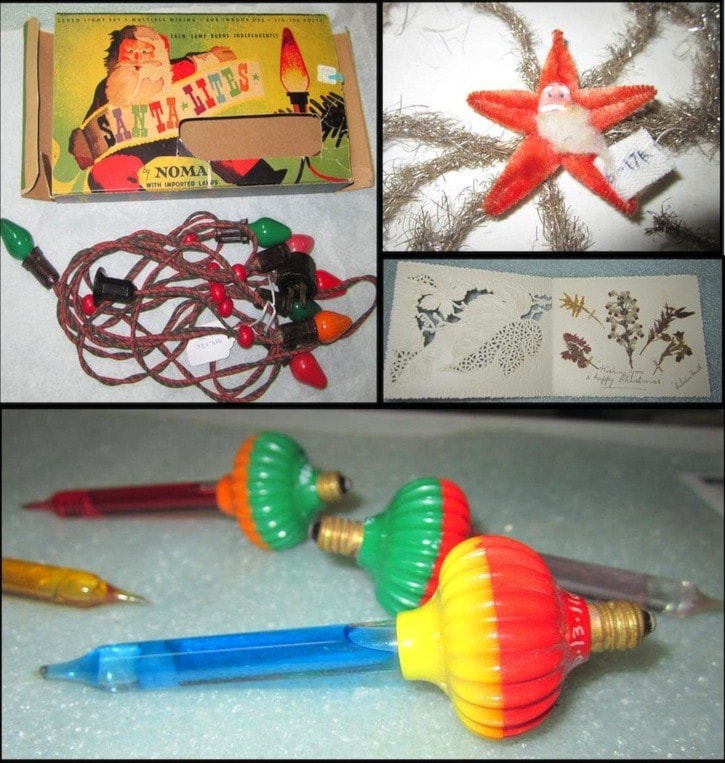This time of year is rich in tradition and celebration for people of many religions. For Christians, it is the celebration of the birth of Jesus Christ. Though there is no historical record that specifically indicates the birth date of Jesus, various Christian churches have come to adopt December 25th as the date. The midwinter solstice was a time of celebration for many people throughout history. This solstice marks the start of increased daylight and was a sign of hope and renewal. In numerous areas, the new Christian faith adopted the midwinter “pagan” festivities so that the birth of Jesus became the focus of celebrations during that time. Many of the Christmas artifacts in our collections can be related to both the original pagan festivities and newer traditions developed in the 1800s.
Candles were once a vital part of Christmas. Once upon a time, the Christmas season did not end until the festival of candles on February 2nd. This festival was called Candlemas and was originally a Jewish tradition. Additionally, the tradition of the Yule Candle was big in early Northern Europe. The candle had to burn throughout the Christmas festival. Originally, the Yule Candle paid homage to the Sun God and celebrated the Birth of the Sun at the start of a new year. Later, Christianity borrowed this custom and believed the light of the candle signified the influence of Jesus. It was also thought that the flame represented the Star of Bethlehem. In our artifact collection are numerous metal clip-on candle holders. These artifacts clip onto the branches of a tree and hold a small burning candle. We have both a silver and gold variety of clip-on candle holders. Every Christmas, the silver clips are used to decorate our Christmas tree inside Moss Cottage. Putting candles on Christmas trees was, however, very dangerous. Eventually, an American inventor would develop a much safer way to illuminate a Christmas tree.
In 1880, Thomas Edison presented the first electric Christmas light display as a way to advertise his invention of the incandescent light bulb. His light display was declared a Christmas miracle! Then, in 1882 Edward Johnson displayed the first electrically illuminated Christmas tree using 80 stringed lights in his Manhattan apartment. We have two different types of Christmas lights in our artifact collection: Bubble lights and Santa Lites. In 1980 a set of screw type bubble lights were donated to the museum (1980.013.011a-j). Bubble lights consist of a covered light bulb and a vial filled with liquid. The low heat generated from the light bulb makes the liquid bubble and boil. Most commonly, the liquid is either oil or methylene chloride, but it is not known what type of liquid is in these particular artifacts. Each of these bubble lights has multi-colored covers over its light bulb and coloured liquid inside its vial. The vials are pointed at the top and overall the light looks like a lit candle when being used. We also have a string of Santa Lites, in their original box, by the brand Noma (1999.003.001a-c). There are seven lights on this string and they are pink, orange and green colours. The tag line on the box says, “each lamp burns independently.” These coloured lights, or lamps, are for indoor use only and use 110-120 volts.
The history of decorating trees began with the pre-Christian tale of the tree-spirits. It was believed that when trees became bare in the fall, spirits had abandoned the trees. To attract the spirits, and leaves, back in the spring, decorations, such as painted stones, were placed on the branches throughout the winter. In early 17th century Germany, a new custom began by bringing small fir trees indoors at Christmas time. Even though the fir trees were evergreens, and would not lose their leaves, the tradition of decorating trees continued. Over the decades, tree decorations have significantly changed and today they often lack old-world charm. In our collection are examples of charming vintage decorations from the 1930s-1950s. These include delicate Santa Clause decorations made from chenille pipe cleaners (1979.026.017a-n). One of these decorations is made of orange pipe cleaner and is shaped into a five sided star with a plaster face of a white bearded man in the middle. On the sides of the fluffy orange star are thick strands of silver tinsel. Another similar ornament is made from the same orange pipe cleaner but is shaped into a body with obvious arms and long legs. The right arm is holding a green pipe cleaner Christmas tree. On the body is a pink plaster face with a white beard. This ornament also has thick strands of silver tinsel.
A more modern tradition is exchanging Christmas cards. Christmas cards were first seen in the early 1840s. Sir Henry Cole was overwhelmed by the prospect of sending a ton of hand-written cards to his family and friends at Christmas. He asked John Horsley, a member of the Royal Academy, to design him a Christmas card with a greeting. Eventually, in November 1843, Horsley delivered 1,000 printed cards on stiff cardboard. They were made by lithography and hand-colouring. Cole ended up selling the cards for one shilling each. Unfortunately, this Christmas card project failed and it wasn’t until the 1860s, when a cheaper printing method was available, that Christmas cards became a tradition. In our archive collection are numerous Christmas cards and postcards. One card from 1902 is very delicate. It is a white embossed card with cut-out maple leaf and floral designs (1980.013.042b). Inside the fragile card are five small pressed flowers. The wording inside says, “Wishing you a happy Christmas-Caledon Heath.” Written on the back of the card is, “With love from Angelique Pietersen Xmas 1902.”
The Sooke Region Museum would like to extend a warm thank you to everyone who participated in our annual event, Moss Cottage Christmas, on December 7th. Happy Holidays!
Brianna
Shambrook
Collections and Exhibits
Manager Sooke Region Museum
